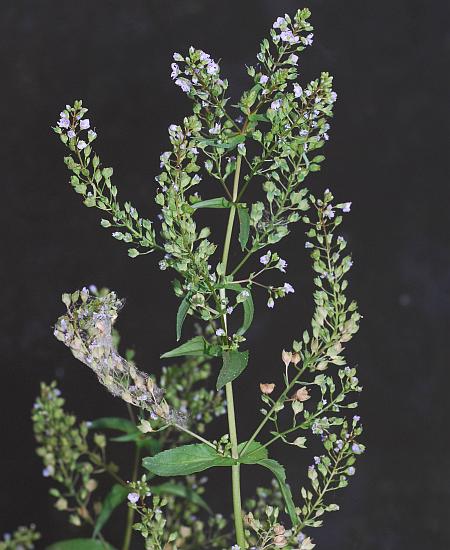Veronica anagallis-aquatica L.
Water Speedwell

Introduced
CC = *
CW = -5
MOC = 18
© SRTurner
Veronica anagallis-aquatica L.Water Speedwell | |
 |
Introduced CC = * CW = -5 MOC = 18 |
© SRTurner |
|
Family - Plantaginaceae Habit - Rhizomatous perennial forb. Stem - Ascending to erect, though sometimes flattened by flooding, to 60 cm, glabrous or sparsely to moderately pubescent with minute, gland-tipped hairs toward the tip (and along the inflorescence axis).
Leaves - Alternate, simple. Upper and median leaves sessile, the lower leaves sometimes short-petiolate. Vegetative stems with mostly short-petiolate leaves are sometimes produced late in the season. Leaf blades 1.5-8.0 cm long, mostly 1.5-3.0 times as long as wide, broadly lanceolate to ovate or oblong-ovate, broadest at or more commonly below the midpoint, sharply pointed at the tip, rounded to truncate or shallowly cordate at the base, those of the sessile leaves more or less clasping the stems, the margins unlobed, flat, mostly subentire, usually with at least a few, widely spaced, minute teeth, the surfaces glabrous or the undersurface inconspicuously glandular-hairy toward the base of the midvein.
Inflorescences - Axillary racemes, usually in opposite pairs at the stem nodes (1 per leaf), open at maturity, with 25-60 flowers, the bracts 1.5-4.0 mm long, much smaller than the foliage leaves, linear to narrowly lanceolate. Flower stalks 2.5-5.0 mm long at flowering, to 8 mm long at fruiting, ascending or curved upward at flowering and fruiting.
Flowers - Calyces 3.0-5.5 mm long, the lobes unequal or slightly unequal, the upper 2 lobes then slightly shorter than the lower 2 lobes, deeply 4-lobed, the lobes lanceolate to broadly lanceolate, glabrous or minutely glandular-hairy toward the base. Corollas 5-10 mm wide, pale blue to light blue, pale purple, or light bluish purple with darker veins, the throat white or sometimes pale greenish-tinged at the base, the lobes loosely cupped upward. Style 1.5-3.0 mm long at fruiting.
Fruits - Capsules 2.5-4.0 mm long, mostly slightly longer than wide, broadly obovate to more or less circular in profile, somewhat turgid, the notch very shallow, the surfaces and margins glabrous or a few minute glandular hairs present along the margins, usually dehiscing both along and between the sutures into 4 valves. Seeds numerous, 0.3-0.5 mm long, strongly flattened on one side and somewhat convex on the other, the surfaces appearing smooth or slightly pebbled, light brown to brown.
Flowering - April - September. Habitat - Streambanks, pond margins, sloughs, moist bases of bluffs, disturbed wetlands; often emergent aquatics. Origin - Eurasia, possibly circumboreal. Lookalikes - V. catenata. Other info. - This distinctive species has been found in several scattered counties in Missouri but is generally uncommon in the state. It is much more common in states to our west, though it does occur to some extent in most of the continental U.S. The plant is recognized by its wet habitat and axillary racemes of small, pale bluish flowers, and sessile, clasping leaves. The entire plant is glabrous. It is closely related to the native V. catenata, from which it may be distinguished by virtue of bearing its fruits on ascending (rather than spreading) stalks. The plant occurs in moist areas, sometimes growing in shallow water. Photographs taken at the San Pedro Riparian National Conservation Area, Cochise County, AZ, 5-27-2016 (SRTurner). |